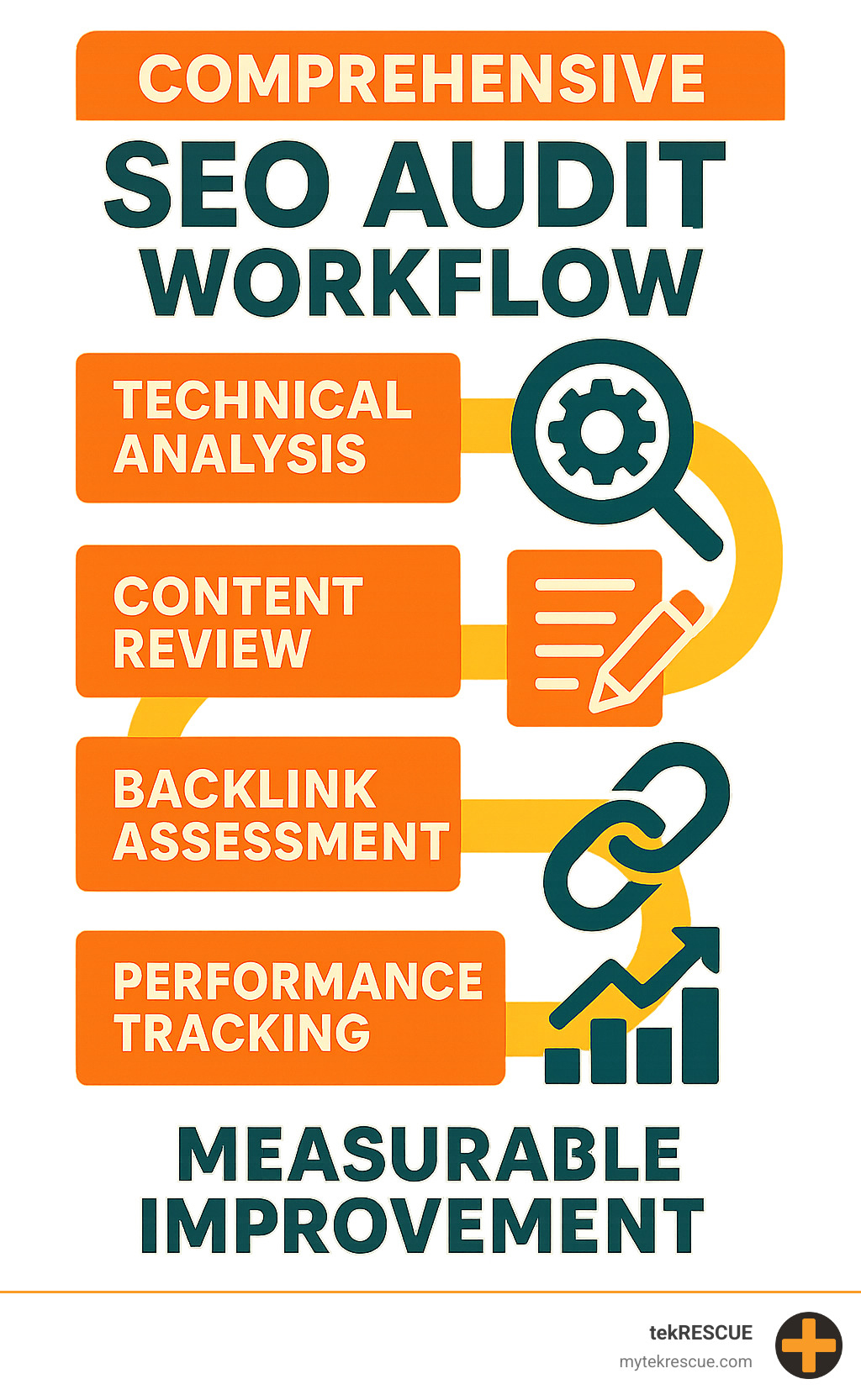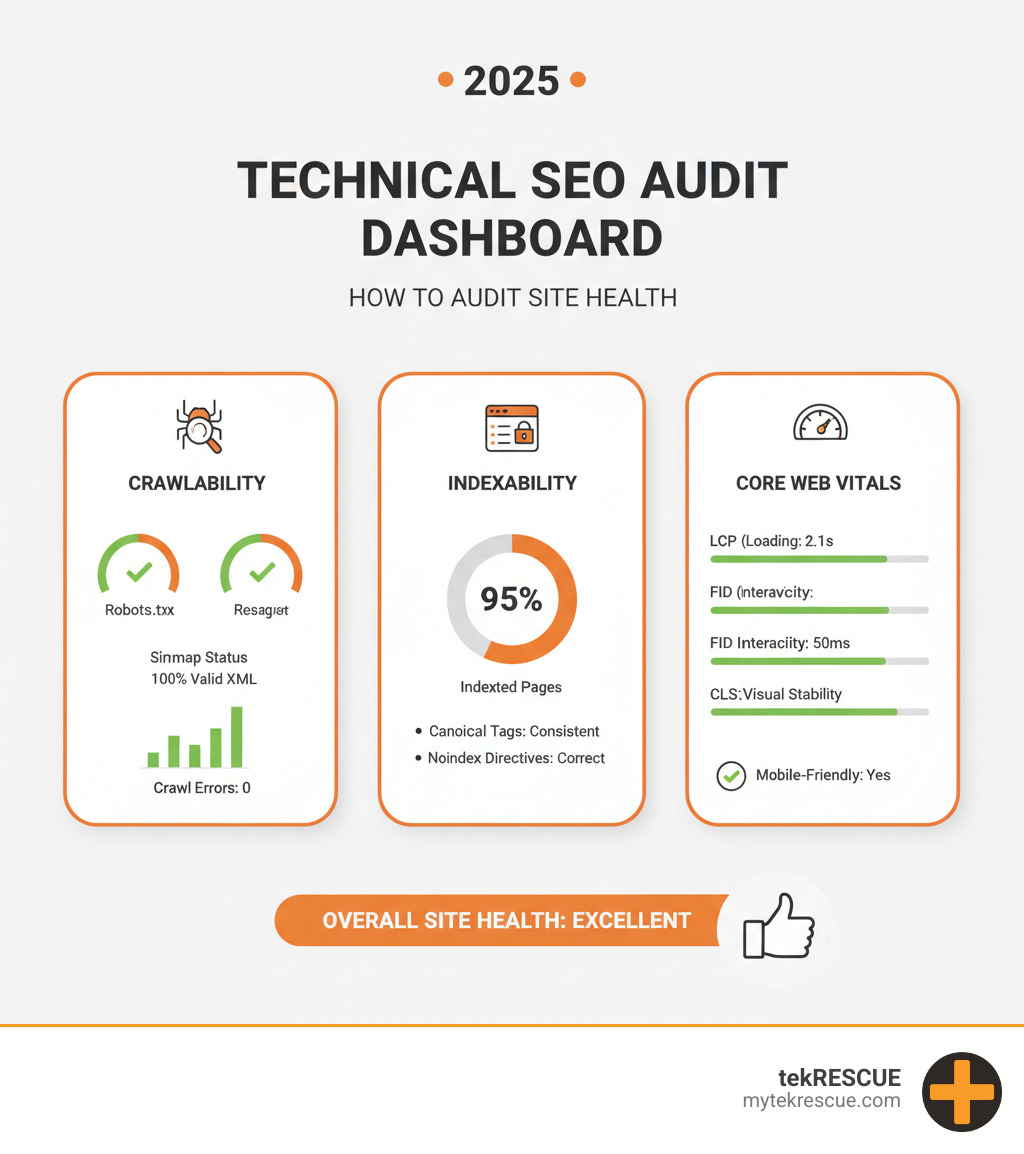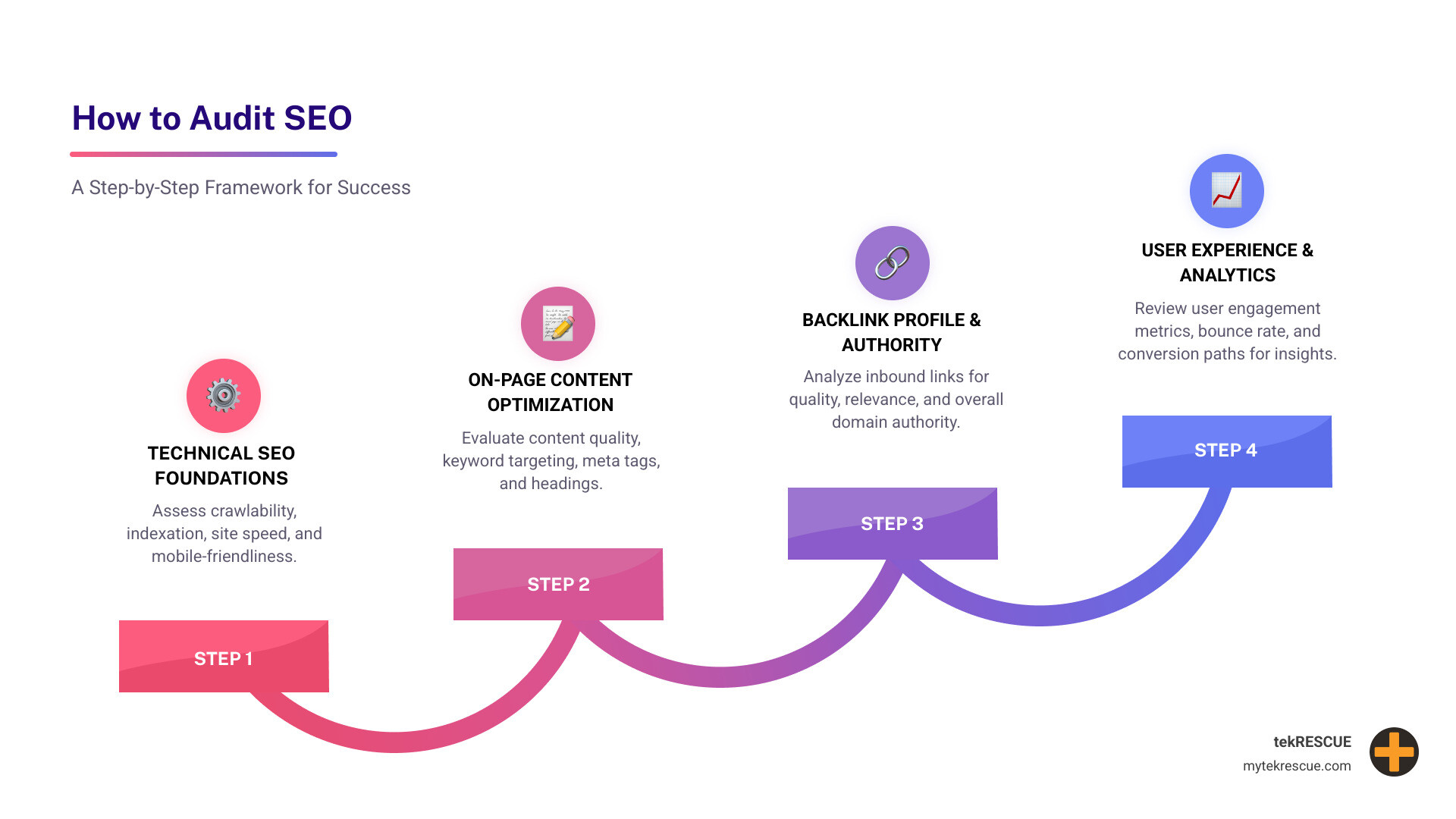

How to Audit SEO Like a Pro (Even If You’re Not One)
Knowing how to audit is the critical first step before investing more in digital marketing. Many websites have thousands of hidden SEO issues. Like duplicate content, missing meta descriptions, or poor mobile performance, that quietly hurt search visibility and cost businesses revenue. The good news is that fixing these issues can lead to significant traffic growth.
Quick Auditing Steps:
- Check indexing – Use “site:yourdomain.com” in Google
- Crawl for technical errors – Run a tool like Screaming Frog
- Test mobile-friendliness – Use Google’s Mobile-Friendly Test
- Analyze page speed – Check Google PageSpeed Insights
- Review Core Web Vitals – Look in Google Search Console
- Audit content quality – Find thin or duplicate content
- Examine backlink profile – Use a tool like Ahrefs or SEMrush
- Benchmark competitors – Compare keywords and authority
Most business owners don’t know what to look for, assuming their site is fine because it looks good. However, search engines often see a different picture filled with crawl errors and optimization gaps. I’m Randy Bryan, founder of tekRESCUE. I’ve helped many of businesses in Central Texas improve their digital presence, and I know that a proper SEO audit can be the difference between a site that generates leads and one that gets lost. We’re here to walk you through the process we use to fix the issues holding your website back.

How to Audit SEO: Step-by-Step Framework
An SEO audit is a comprehensive health check for your website, evaluating its optimization for search engines. It covers technical health, content quality, backlinks, and user experience to find opportunities that boost visibility and traffic. Neglecting audits is like having a storefront with locked doors—it prevents search engines and customers from finding you, leading to lost revenue. Our process covers a site crawl, indexing checks, Core Web Vitals, content quality, mobile-friendliness, backlinks, and user experience to ensure peak performance.
How to Audit SEO for Technical Health
Technical SEO is the foundation of your website. If search engines can’t crawl and index your site, your other efforts are wasted. Here’s what to check:
- Crawlability: Use Google Search Console to find crawl errors (like “404 Not Found”) that prevent bots from accessing your pages. Tools like Screaming Frog can also perform a site crawl to find issues.
- Broken Links: Fix broken internal and external links to improve user experience and preserve link equity.
robots.txt& XML Sitemap: Ensure yourrobots.txtfile isn’t accidentally blocking important pages. Your XML sitemap should be up-to-date to help search engines find your content.- HTTPS: A secure site (HTTPS) is a Google ranking factor and essential for user trust. Migrate from HTTP if you haven’t already.
Core Web Vitals and Page Speed:
Core Web Vitals are key metrics for user experience and a known ranking factor. You can check them in Google Search Console.
- Largest Contentful Paint (LCP): Measures loading speed. Aim for under 2.5 seconds.
- Interaction to Next Paint (INP): Measures page responsiveness. Aim for under 200 milliseconds.
- Cumulative Layout Shift (CLS): Measures visual stability. Aim for a score of 0.1 or less.

Index & Site Architecture Checks
Next, ensure search engines can properly index and steer your site.
- Indexing Status: Use the “site:yourdomain.com” search in Google for a quick check. For a detailed view, use the “Pages” report in Google Search Console to find pages that are indexed or excluded.
- Canonical URLs: To avoid duplicate content issues where multiple URLs show the same page, use canonical tags (
<link rel="canonical" ...>) to specify the preferred version. - Site Architecture: A “flat” architecture, where important pages are within three clicks of the homepage, helps users and search engines. Use internal links to guide bots and pass authority between pages.
- Mobile-Friendliness: Google uses mobile-first indexing, so your site must be mobile-friendly. Use Google’s Mobile-Friendly Test to check for issues.
- URL Consistency: Ensure your site uses one consistent version (e.g.,
https://www.yourdomain.com) and redirects all other versions (like HTTP or non-WWW) to it. This prevents duplicate content and consolidates SEO value.
| Feature | HTTP (Hypertext Transfer Protocol) | HTTPS (Hypertext Transfer Protocol Secure) |
|---|---|---|
| Security | No encryption, data sent in plain text | Encrypted, secure data transmission |
| SEO Impact | Minor negative ranking factor | Minor positive ranking factor |
| Browser Trust | “Not Secure” warning in modern browsers | Secure lock icon, builds user trust |
How to audit SEO for Content & UX
High-quality content and a positive user experience (UX) are critical for ranking well. Google rewards sites that satisfy users.
On-Page SEO Elements:
- Meta Tags: Write compelling meta titles (55-60 characters) and meta descriptions (120-150 characters) with your primary keyword to improve click-through rates from search results.
- Headings (H1, H2): Use a single H1 for your page title and H2s for main sections to structure content for readability and SEO.
- Content Quality: Your content must be original, comprehensive, and helpful. Avoid thin or duplicate content. Sometimes, pruning low-value pages can improve overall site performance.
User Experience (UX) and Structured Data:
- UX Signals: A good user experience reduces bounce rates and increases time on site. Focus on readability, intuitive navigation, and fast page speed.
- Structured Data (Schema): Implement schema markup to help search engines understand your content. This can lead to “rich snippets” in search results, like star ratings or FAQs, which can significantly boost click-through rates. Since most sites don’t use it, it’s a great way to stand out.

Backlink & Authority Review
Backlinks (links from other sites to yours) are like “votes of confidence” that signal authority to Google. A strong backlink profile is crucial for SEO.
Analyzing Your Backlinks:
Use tools like Ahrefs or Semrush to analyze your backlink profile. Focus on:
- Quality over Quantity: A few links from high-authority, relevant sites are better than many low-quality ones.
- Toxic Links: Identify and remove or disavow links from spammy sites that could harm your rankings. For guidance, refer to Google’s policies on Scientific research on potential spam.
- Anchor Text: Ensure your anchor text (the clickable text in a link) is diverse and looks natural, not over-optimized with exact-match keywords.
Competitor Analysis:
Analyze your competitors’ backlink profiles to find “link gaps”—sites linking to them but not you. This reveals new link-building opportunities and helps you understand what strategies work in your industry.
Benchmarking, Reporting & Frequency
An SEO audit is an ongoing process, not a one-time fix. After implementing changes, you must track results, benchmark against competitors, and set a regular audit schedule.
Benchmarking and Tracking:
- Competitor Analysis: Compare your organic traffic, keyword rankings, and backlink profile to your competitors to find gaps and opportunities.
- Tracking KPIs: Use Google Analytics and Google Search Console to monitor organic traffic, keyword positions, and Core Web Vitals. This helps measure the ROI of your efforts.
Audit Frequency:
How often you audit depends on your site’s size and industry. A good rule of thumb is:
- Quarterly: For most active businesses, to stay on top of new issues and algorithm changes.
- Annually: At a minimum, for a comprehensive health check.
- After a Launch/Redesign: Immediately audit to catch critical errors early.
Common Fixes and Tools:
Common issues like broken links, duplicate content, and slow page speed can be fixed with 301 redirects, canonical tags, and image optimization. For a full audit, use a mix of free tools like Google Search Console and paid tools like Semrush or Ahrefs.
Next Steps For Your Business
Now you understand the key elements that drive performance, from technical health and content to backlinks and user experience. A routine audit is a powerful tool for growth, with many sites seeing significant traffic increases after fixing hidden issues.
However, knowing what to do and having the time and expertise to do it are different challenges. The technical details can be overwhelming for busy business owners. Prioritizing fixes, like crawl errors versus meta descriptions, requires experience to ensure you’re focusing on what will make the biggest impact.
At tekRESCUE, we make complex SEO audits simple and actionable. We don’t just deliver a technical report; we provide a clear, prioritized roadmap that aligns with your business goals. Our team has helped hundreds of businesses in Central Texas turn their websites into assets that generate leads, not get lost in search results.
Every day that SEO issues go unaddressed is a day of lost opportunities. Ready to stop guessing and start growing? Let’s create a clear action plan to fix what’s holding your website back.
Contact us today to schedule your comprehensive SEO audit and transform your website into a lead-generating machine.
Table of Contents











